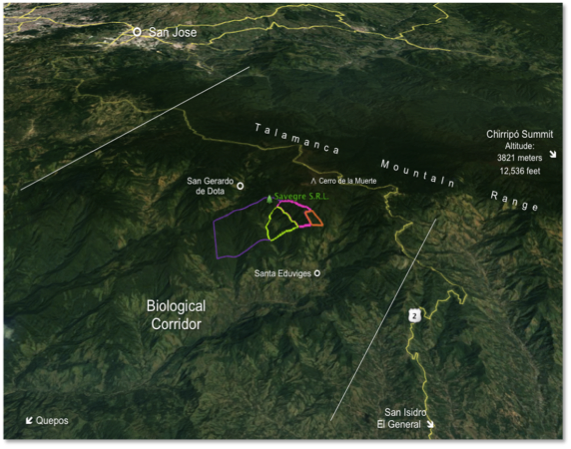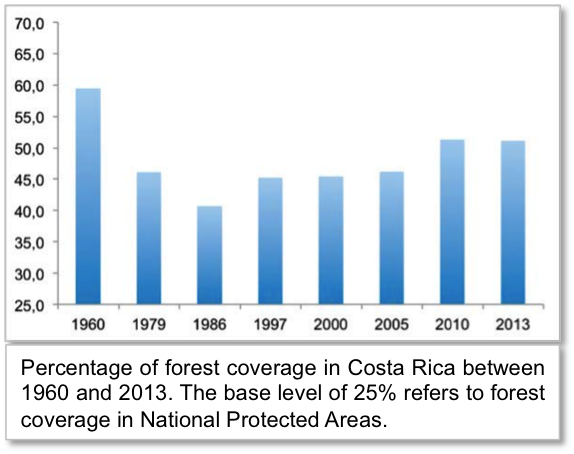Ecological Connectivity
Connectivity in UNESCO-Designated Savegre Biosphere Reserve
As noted on the Biodiversity page, Savegre S.R.L.’s forestlands are located within the Savegre Biosphere Reserve, a site designated by the United Nations Educational, Scientific and Cultural Organization (UNESCO) in 2017 and which UNESCO describes as having:
"a high value in terms of ecosystems, biodiversity, water resources and connectivity."

Few Biological Corridors Remaining on the Pacific Coast of Central America
Savegre S.R.L.’s forestlands constitute a significant portion of what the Costa Rican Ministry of Environment and Energy (MINAE, 2004) considers to be one of the few remaining biological corridor on the Pacific coast of Central America. The Central American Commission for Environment and Development (CCAD) defines a biological corridor as a “geographically defined area which provides connectivity between landscapes, ecosystems and habitats […] and ensures the maintenance of biodiversity and ecological and evolutionary processes.” Because of the vital role that biological corridors play in providing such landscape, ecosystem, and habitat connectivity that allows species to survive and thrive––and in light of the fact that few such corridors remain in Central America––it is evident that Savegre S.R.L.’s forestlands play an important ecological and environmental role in the region.

Extensive Loss of Forestlands Due to Human Activity
Throughout modern history, humans have caused extensive deforestation in pursuit of economic and social development. Costa Rica’s forestlands, despite the country’s now renowned dedication to conservation, have unfortunately suffered the same fate in the past. As noted in the table above (Ambientico, 2015), in the 1960s the total forest coverage in Costa Rica was at around 59.8%, but then the coverage dropped precipitously to a low of around 40.8% in the year 1986. Thanks to new and strengthened environmental policies in the 1990s, including the Environmental Services Payment (PSA) Program, there has been a recuperation of forest coverage––though as of 2013 and in more recent years the levels still remain below the 1960s level. Expansive forest coverage is vital to maintaining ecological connectivity because it allows species to move safely about their natural habitats without human interruption.
Why Is Ecological Connectivity So Important?
Regarding the importance of ecological connectivity, the United States Environmental Protection Agency (EPA) states the following in their Report on the Environment:
“As part of their natural functioning, ecological systems remove particulate matter and carbon dioxide from the air, purify surface and ground water, reduce flooding, and maintain biological diversity. These functions depend on a connected ecological ‘framework’ of high quality land consisting of central hubs interconnected by corridors that provide for the movement of energy, matter, and species across the landscape. This framework of connectivity is threatened by agricultural and silvicultural practices, road development, and ‘urban sprawl’ that fragment the landscape. Maintaining ecological connectivity protects the entire system.”
Our Duty to Protect Remaining Forestlands
In 2019 the United Nations Intergovernmental Science-Policy Platform on Biodiversity and Ecosystem Services (IPBES) released an extensive Global Assessment Report warning that, on a worldwide scale, a large percentage of forestlands and the species that inhabit them are under imminent and existential threat. For this reason it is our duty––humankind’s duty––to protect and conserve remaining forestlands.
Some of the key statistics and facts from the IPBES report include:
30% reduction in global terrestrial habitat integrity caused by habitat loss and deterioration
Up to 1 million species threatened with extinction, many within decades
75% terrestrial environment “severely altered” to date by human actions (marine environments 66%)
More than 20% decline in average abundance of native species in most major terrestrial biomes since 1900
An average of 25% of species threatened with extinction across terrestrial, freshwater and marine vertebrate, invertebrate and plant groups
47% reduction in global indicators of ecosystem extent and condition against their estimated natural baselines, with many continuing to decline by at least 4% per decade
More than 500,000 (+/-9%) of the world’s estimated 5.9 million terrestrial species with insufficient habitat for long term survival without habitat restoration
“We see quite clearly that what happens to the nonhuman happens to the human. What happens to the outer world happens to the inner world. If the outer world is diminished in its grandeur then the emotional, imaginative, intellectual, and spiritual life of the human is diminished or extinguished. Without the soaring birds, the great forests, the sounds and coloration of the insects, the free-flowing streams, the flowering fields, the sight of the clouds by day and the stars at night, we become impoverished in all that makes us human.”
